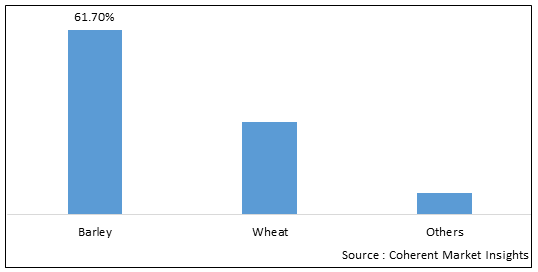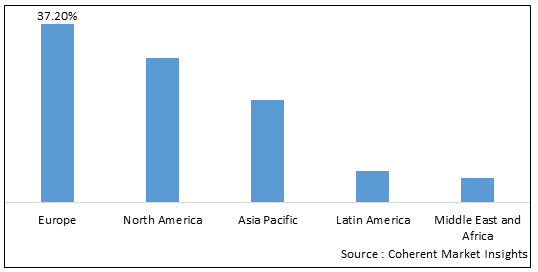Malt Ingredient Market is estimated to be valued at USD 6,830.5 Mn in 2025 and is expected to reach USD 10,068.8 Mn in 2032, exhibiting a compound annual growth rate (CAGR) of 5.7% from 2025 to 2032. Malt is one of the most popular cereal grains that is produced by using barley, which is soaked in water and then dried in hot water. This process allows the germination of barley. This process is called malting. The malting process enables the starches in the grains to be converted into sugars such as glucose and fructose and glucose. There are two types of malt powder available in the market called diastatic and nondiastatic. A diastatic malt product is used during baking in order to ensure the proper rise of the baked product. Nondiastatic does not contain any enzymes and is thus mainly used as a flavor in beverages. It is gaining huge demand as a functional ingredient in the preparation of functional foods such as nutritional foods and drinks as it contains essential vitamin B and amino acids and is also considered a rich source of fiber.
Global Malt Ingredient Market- Impact of Coronavirus (Covid-19) Pandemic
Malt ingredients are widely used in the food and beverage industry, particularly in the production of beer, whiskey, and malt-based food products. Some of the major factors that are affected by the pandemic are the closure of bars and restaurants. Many countries implemented strict lockdown measures, leading to the closure of bars, restaurants, and other food service establishments. This resulted in a significant decline in demand for malt-based beverages, such as beer, which directly affected the malt ingredient market. This further disrupted the global supply chain and hindered the growth of the market. Overall, the global malt ingredient market faced challenges due to the covid-19 pandemic.
Figure 1. Global Malt Ingredient Market, By Source, 2025

To learn more about this report, Download Free Sample
Global Malt Ingredient Market - Drivers
Growing demand for functional food among consumers is expected to foster the market growth of malt ingredients. According to the report published by the Institute of Food Technologists in April 2020, sales of natural and organic foods reached US$ 262 billion in 2020; functional/fortified foods totalled US$ 251 billion. Hence, the rising demand for functional food is expected to accelerate the market growth of malt ingredients.
The market for malt ingredients is driven primarily by rising demand from the worldwide food and beverage industry. It is also expected that increased demand for dairy products and beer will fuel the demand for malt ingredients in the years to follow. However, the emerging market for malt ingredients is expected to open up new opportunities. For instance, The global food and beverages market grew from $6,729.54 billion in 2022 to $7,221.73 billion in 2023 at a compound annual growth rate (CAGR) of 7.3%.
Malt Ingredient Market Report Coverage
| Report Coverage | Details | ||
|---|---|---|---|
| Base Year: | 2024 | Market Size in 2025: | USD 6,830.5 Mn |
| Historical Data for: | 2020 To 2024 | Forecast Period: | 2025 To 2032 |
| Forecast Period 2025 to 2032 CAGR: | 5.7% | 2032 Value Projection: | USD 10,068.8 Mn |
| Geographies covered: |
|
||
| Segments covered: |
|
||
| Companies covered: |
Axereal Group, Cargill, Incorporated, RAGLETH LTD., GrainCorp Malt Group, IREKS GmbH, Dohler GmbH, VIVESCIA Industries, Muntons plc, Polttimo Oy, Malt Products Corporation, Briess Malt & Ingredients Co., Malteries Soufflet SAS, and Simpsons Malt Limited |
||
| Growth Drivers: |
|
||
| Restraints & Challenges: |
|
||
Uncover macros and micros vetted on 75+ parameters: Get instant access to report
Global Malt Ingredient Market - Restraints
The non-availability of substitutes with the same characteristics as malts can lead to a shortage of malt ingredients, which is expected to hinder the market growth. However, the shortage can be met by using other types of grains, such as rice, which does not contain the same nutritional as well as other qualities as barley and wheat. Hence, this is expected to restrict market growth over the forecast period. Moreover, the increasing usage of malt in breweries is leading to a shortage of malt ingredients, which is expected to restrict market growth. Malt is a crucial raw material used in the manufacturing of gluten-free beer. According to the Coherent Market Insights analysis, around 75%–78% of total barley malt produced globally is utilized by the brewing industries, and hence a moderate volume remains for other applications such as bakery, pharmaceuticals, food, and distillery applications. Moreover, seasonal variations and the availability of cereal grains of good quality are likely to limit the growth of the global market.
Global Malt Ingredient Market - Segmentation
On the basis of the source in 2025, the barley segment has accounted for the largest market share of 61.70% in terms of value, followed by wheat and others. Barley is the most common source of malt ingredients. It is primarily used for malting due to its favourable characteristics such as high enzyme content and starch composition. Wheat is another significant source of malt ingredients. While not as commonly used as barley, it is employed in the production of certain malted beverages and food products.
Figure 2. Global Malt Ingredient Market, By Region, 2025

To learn more about this report, Download Free Sample
Global Malt Ingredient Market - Opportunities
Expanding food and beverage industry, especially in the Asia Pacific region is expected to provide potential growth opportunities for the malt ingredient. India Brand Equity Foundation, the Indian food processing industry accounts for 32 percent of the country’s total food market, one of the largest industries in India, and is ranked fifth in terms of production, consumption, and export. In 2020 India’s exports stood at US$ 1.8 billion. Hence, the growing food processing industry is expected to accelerate market growth.
Growing production of beer is expected to propel the market growth of malt ingredients. Barley malt is mainly used as a flavor in the production of beer. According to the National Beer Wholesalers Association, in 2020, the U.S. beer industry shipped (sold) 243.6 million barrels of beer – equivalent to more than 3.1 billion cases of 24-12 ounce servings. In addition, the industry shipped approximately 2.3 million barrels of cider, equivalent to more than 38.4 million cases.
Global Malt Ingredient Market - Trends
Rising consumption of non-alcoholic malt drinks is expected to foster the market growth of malt ingredients. For instance, in August 2019, Coca-Cola launched its global brand Barbican in India, a high-volume non-alcoholic malt drinks market. A non-alcoholic malt drink is a high-energy beverage, brewed in the same fashion as beer or ale. Hence, the rising demand for energy drinks is accelerating market growth.
Growing consumption of sugar-free bakeries is expected to accelerate the market growth of malt ingredients over the forecast period. For instance, in November 2018, Ulrick & Short launches a gluten-free sugar replacer for bakery goods. Avanté 9 is the latest in Ulrick & Short's sugar reduction range and promises to reduce more than 20% of sugar in gluten-free bakery formulations while maintaining the volume, texture, and crumb structure.
Global Malt Ingredient Market - Regional Insights
Based on region, Europe is expected to dominate the global malt ingredients market with 37.20 percent. Due to the high concentration of bakeries and breweries in nations like Germany, Spain, France, the U.K., Italy, and the Netherlands. The growing emphasis on malt ingredient production and processing to broaden the market's application base will also contribute to the market's expansion in this area. Due to rising demand for packaged food and bakery goods as well as rising health consciousness among consumers in this region, the Asia Pacific region is anticipated to experience a higher CAGR in the global malt ingredients market.
Global Malt Ingredient Market - Recent Developments
Global Malt Ingredient Market - Key Players
Key players operating in the global malt ingredient market include Axereal Group, Cargill, Incorporated, RAGLETH LTD., GrainCorp Malt Group, IREKS GmbH, Dohler GmbH, VIVESCIA Industries, Muntons plc, Polttimo Oy, Malt Products Corporation, Briess Malt & Ingredients Co., Malteries Soufflet SAS, and Simpsons Malt Limited
*Definition: Malt refers to cereal grains that have been soaked and dried, changing their chemical composition and flavor. Barley is the most common grain for malting, but malt makers or maltsters can also malt other cereal grains like wheat, oats, corn, rye, and rice.
Share
Share
Missing comfort of reading report in your local language? Find your preferred language :
Transform your Strategy with Exclusive Trending Reports :
Frequently Asked Questions
Select a License Type
Joining thousands of companies around the world committed to making the Excellent Business Solutions.
View All Our Clients